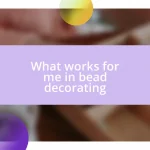Key takeaways:
- The author’s initial encounter with lampwork sparked a lifelong passion, leading to a journey of self-discovery through glass art.
- Key historical figures, such as Michael Taylor and Vittorio Costantini, played a significant role in shaping modern lampworking techniques and inspiring current artists.
- Modern advancements in technology and community engagement have transformed lampwork, enhancing creativity and fostering collaboration among artists.

My personal introduction to lampwork
My first encounter with lampwork was nothing short of serendipitous. I remember wandering through a vibrant craft fair, captivated by the glimmers of color emanating from a table laden with glass beads. It felt like stumbling into a hidden treasure trove, and I was instantly drawn in.
Once I signed up for my first lampwork class, excitement coursed through my veins, mingled with a hint of nervousness. I can still recall the moment I held the torch for the first time, feeling both awe and fear. What if I let my inexperience get the best of me? Yet, as the molten glass began to form under my guidance, a miraculous transformation occurred, and I found myself in a meditative flow that I hadn’t experienced before.
That initial spark ignited a flame of passion in me that still burns today. Each bead I created told a story, reflecting fragments of my emotions and experiences. Have you ever pursued a hobby that felt like a pure expression of your inner self? For me, lampwork is precisely that, a beautiful journey of self-discovery wrapped in colorful glass.

Understanding lampwork techniques
Understanding lampwork techniques often begins with familiarization with the essential tools of the trade. I can vividly recall the first time I laid eyes on a lampwork torch; its design was both intimidating and alluring. The flame, after all, is where the magic happens—melting glass to create beautiful forms. Mastery of these tools requires practice and patience, much like any art form.
Another fascinating aspect of lampwork is the various techniques used to create different effects. For instance, stringer work, where thin strands of colored glass are used, allows for intricate detailing that adds depth to my pieces. Each technique tells a story; it’s all about finding the right method to capture the emotion I want to convey. Have you ever experimented with a technique that just clicked for you? For me, encasing—a technique where clear glass encapsulates a colored core—opened up new dimensions in my creations.
The beauty of lampwork lies not only in the final product but also in the journey of creation. I often find my mind wandering during the process, like when I first discovered the technique of frit application—sprinkling crushed glass onto my piece. The vibrant pops of color would surprise me each time, reminding me that creativity often embraces spontaneity. It’s a dance between control and chaos, and that balance is both exhilarating and grounding.
| Technique | Description |
|---|---|
| Striking | A technique that involves heating glass to bring out its true color, often revealing stunning hues. |
| Stringer Work | Utilizes thin strands of glass to add intricate designs and details. |
| Encasing | Involves layering clear glass over colored glass to create depth and dimension in the piece. |

Key historical figures in lampwork
Lampwork has a rich history shaped by several remarkable figures. Among them, the name of Michael Taylor often stands out. He played a pivotal role in the revival of lampworking techniques in the 20th century, particularly in the United States. I remember being inspired by his innovative approaches to color and design when I first learned about his work. It motivated me to experiment with my color palette more boldly.
Here are some other key historical figures in lampwork:
- Vittorio Costantini: Renowned for his intricate bead-making skills that elevated lampwork to an art form.
- Robert LEDA: Credited with developing the first mass-produced lampwork beads, making glass art more accessible.
- Joan de Lespagnols: A pioneer in modern lampwork techniques, known for her whimsical and playful glass creations.
Each of these artists brought something unique to the craft, reminding us all of the endless possibilities in lampworking. It’s fascinating to think about how their innovations paved the way for my own creativity and exploration in this art form!

Evolution of lampwork styles
As lampwork evolved, so did the styles and techniques that artists embraced. I remember the first time I saw classic Venetian beads; the vibrant colors and intricate designs were incredibly captivating. This historical style, with its bold artistry, set the groundwork for modern lampwork and inspired countless artists, myself included, to explore the delicate balance between tradition and innovation.
In the years that followed, I noticed a noticeable shift towards more contemporary designs, often incorporating mixed media. It was a revelation for me when I experimented with combining lampwork with metal elements—it created a striking contrast that gave my pieces a fresh perspective. Have you ever tried to blend different materials in your work? That experience reinforced my belief that the evolution of lampwork styles is a journey that invites each artist to leave their mark.
Today, lampwork continues to push boundaries, showcasing techniques like sculpting and detailed figure work. When I first attempted to create a miniature animal, I felt both exhilarated and intimidated by the challenge. The intricate details made me appreciate the fine line between skill and artistry. Isn’t it fascinating how the evolution of lampwork styles not only reflects artistic preferences but also personal growth as an artist? For me, every new style I explore feels like an invitation to uncover more layers of creativity within myself.

Significant cultural influences on lampwork
Lampwork has been significantly influenced by various cultures throughout history, each contributing unique techniques and aesthetics. For example, Ancient Egyptians were among the first to create glass beads, using lampworking methods that reflected their vibrant artistry. It’s incredible to think that the intricate designs I admire today have roots stretching back thousands of years! When I first learned about these ancient techniques, I felt a connection to a shared creative spirit, pushing me to appreciate the versatility of glass.
Moving forward in time, the influence of Venetian glassmakers cannot be overstated. Their contributions to lampwork not only set high standards for craftsmanship but also introduced a dramatic flair for color and design. I recall visiting a gallery where I saw contemporary artists paying homage to Venetian styles. The experience inspired me to experiment with traditional techniques while adding my own twist—this fusion of past and present created a thrilling artistic dialogue. Isn’t it fascinating how cultural influences can rejuvenate our creativity?
In more modern contexts, the American glass scene, predominantly shaped in the late 20th century, has been marked by a diverse blend of cultural inspiration. I vividly remember the first time I attended a glassblowing workshop that emphasized storytelling through art. The idea that I could express personal narratives through lampwork struck a chord with me. It made me realize how cultural influences don’t just shape the techniques; they also imbue our creations with deeper meanings. Each bead I craft now feels like a piece of my own story, woven into the tapestry of lampwork history.

Modern advancements in lampwork
Modern lampwork has undergone remarkable advancements, thanks to both technological innovations and artistic explorations. For instance, the introduction of the latest torches and glass types has significantly enhanced the quality and precision of our creations. I remember the exhilarating moment when I first tried a high-temperature torch; it opened up a world of possibilities, allowing me to experiment with finer details and richer colors. Have you ever had a tool change the way you create? It’s magical how the right equipment can ignite a new passion.
Today, artists are increasingly incorporating digital tools into the lampwork process. The ability to use software for design planning has changed the game entirely. I still recall the first time I sketched out a complex design on my tablet before hitting the torch; it was a revelation! Transitioning from concept to execution with such clarity felt almost like collaborating with technology. How has digital art influenced your approach to traditional crafts?
Furthermore, the modern lampwork community has become a vibrant space for sharing knowledge and techniques through online platforms and workshops. I often join virtual meetups where fellow artists demonstrate their innovative methods, and every session is a treasure trove of inspiration. This collaborative spirit has not only expanded my skillset but also fostered a sense of belonging in a community that thrives on creativity. Have you found your tribe in the world of art? For me, these connections have enriched my artistic journey and spurred further advancements in my lampwork practice.

Resources for aspiring lampworkers
Finding the right resources as an aspiring lampworker can be a transformative step in your journey. I remember diving into various online forums and discovering a wealth of knowledge shared by seasoned artists. These communities can be incredibly supportive; asking a simple question often leads to a cascade of responses filled with tips and personal experiences. Have you ever felt that rush of excitement when you find a group of people who truly understand your passion?
Books and tutorials are also invaluable resources. I still cherish the first instructional video I watched on bead-making techniques. Seeing each step unfold on screen made the process feel accessible and less intimidating. I learned so much from just a single session! There are countless books out there that offer everything from basic skill sets to advanced artistic concepts, so it’s worth spending some time exploring your options.
Don’t underestimate local classes or workshops! I took a weekend course that not only improved my skills significantly but also connected me with other artists in my area. The joy of working alongside someone who shares your love for lampwork is something truly special. Have you ever found camaraderie in your craft? The friendships I’ve formed during these sessions have turned into collaborative projects, and that shared energy fuels my creativity in ways I never anticipated.














